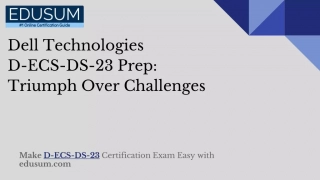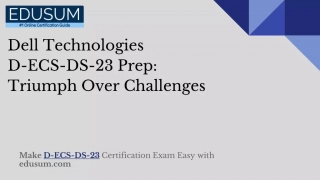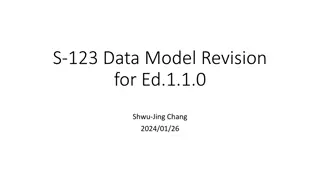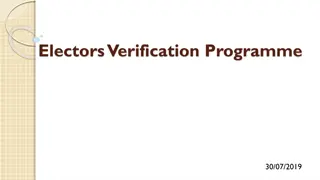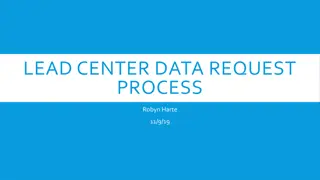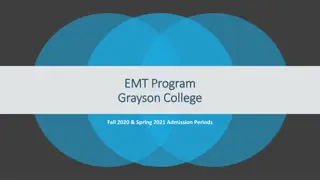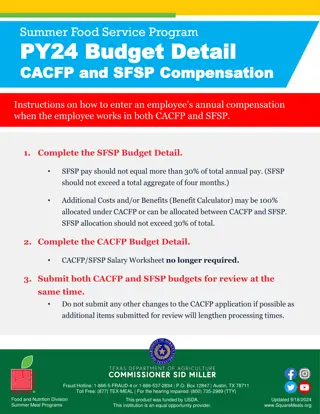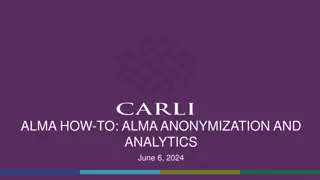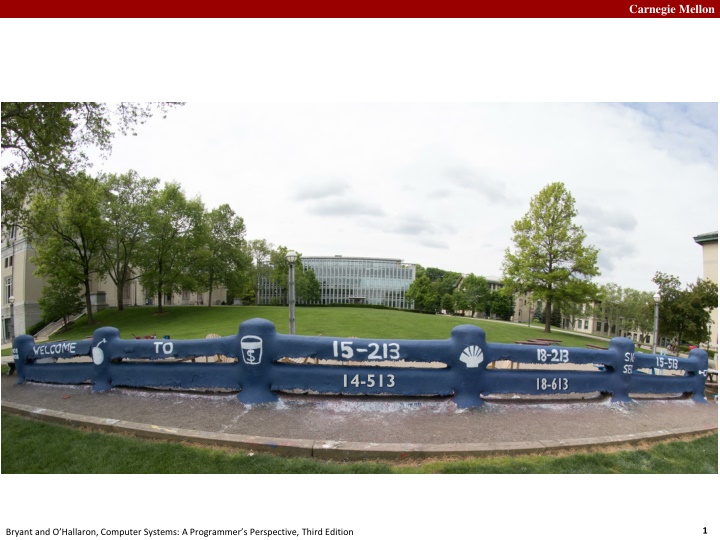
Understanding Virtual Memory in Computer Systems at Carnegie Mellon
Explore the concepts of virtual memory and memory systems as taught at Carnegie Mellon University. Covering topics such as virtual addressing, per-process virtual address space, page tables, and the role of the Memory Management Unit (MMU) in computer systems. Dive deep into the intricate details of computer memory management with real-world examples and case studies from the book "Computer Systems: A Programmer's Perspective".
Download Presentation

Please find below an Image/Link to download the presentation.
The content on the website is provided AS IS for your information and personal use only. It may not be sold, licensed, or shared on other websites without obtaining consent from the author. If you encounter any issues during the download, it is possible that the publisher has removed the file from their server.
You are allowed to download the files provided on this website for personal or commercial use, subject to the condition that they are used lawfully. All files are the property of their respective owners.
The content on the website is provided AS IS for your information and personal use only. It may not be sold, licensed, or shared on other websites without obtaining consent from the author.
E N D
Presentation Transcript
Carnegie Mellon 14-513 18 18- -613 613 1 Bryant and O Hallaron, Computer Systems: A Programmer s Perspective, Third Edition
Carnegie Mellon Virtual Memory: Details 15-213/15-513: Introduction to Computer Systems 15th Lecture, March 14, 2024 2 Bryant and O Hallaron, Computer Systems: A Programmer s Perspective, Third Edition
Carnegie Mellon Today Review concepts from last lecture Simple memory system example CSAPP 9.6.4 CSAPP 9.7 CSAPP 9.8 Case study: Core i7/Linux memory system Memory mapping 4 Bryant and O Hallaron, Computer Systems: A Programmer s Perspective, Third Edition
Carnegie Mellon Review: Virtual Addressing physical memory 0: 1: 2: 3: 4: 5: 6: 7: 8: CPU Chip Virtual address (VA) 4100 Physical address (PA) 4 MMU CPU ... M-1: Data word Virtual address space is an abstraction, not real memory Physical memory refers to the actual computer memory (DRAM) 5 Bryant and O Hallaron, Computer Systems: A Programmer s Perspective, Third Edition
Carnegie Mellon Review: Per-process Virtual Address Space Each process has its own virtual address space All processes share the same Physical Memory Address translation 0 0 Physical Address Space (DRAM) Virtual Address Space for Process 1: VP 1 VP 2 ... PP 2 N-1 (e.g., read-only library code) PP 6 0 Virtual Address Space for Process 2: PP 8 VP 1 ... ... VP k M-1 N-1 6 Bryant and O Hallaron, Computer Systems: A Programmer s Perspective, Third Edition
Carnegie Mellon Review: Page Table Physical memory (DRAM) Physical page number or disk address Virtual address VP 1 PP 0 Valid VP 2 PTE 0 null 0 1 1 VP 7 VP 4 PP 3 0 1 0 0 Virtual memory (disk) null PTE 7 1 VP 1 Memory resident page table (DRAM) VP 2 VP 3 VP 4 VP 6 VP 7 A page table contains page table entries (PTEs) that map virtual pages to physical pages. 7 Bryant and O Hallaron, Computer Systems: A Programmer s Perspective, Third Edition
Carnegie Mellon Conceptual Question The MMU must know the physical address of the page table in order to read page table entries from memory. Why does it need a physical address? If the MMU knew only a virtual address for the page table, then, in order to find the page table in memory, it would first need to look up the physical address of the page table, in the page table itself, 8 Bryant and O Hallaron, Computer Systems: A Programmer s Perspective, Third Edition
Carnegie Mellon Review: Translating with a k-level Page Table Having multiple levels greatly reduces total page table size Page table base register (part of the process context) VIRTUAL ADDRESS n-1 p-1 0 VPN 1 VPN 2 ... VPN k VPO a Level k page table a Level 2 page table the Level 1 page table ... ... PPN m-1 p-1 0 PPN PPO PHYSICAL ADDRESS 9 Bryant and O Hallaron, Computer Systems: A Programmer s Perspective, Third Edition
Carnegie Mellon Conceptual Questions Why are one-level page tables impractical? For typical system sizes, the table would require more physical memory (e.g., 512 GBs) than most computers have. How does a multi-level page table fix this problem? Only allocates the part of the page table tree that s needed for the virtual addresses the program uses. Why is memory access slower with a multi-level page table than with a one-level page table? A k-level page table requires k memory loads in order to determine the physical address. There is no spatial locality to these loads (see next slide). 10 Bryant and O Hallaron, Computer Systems: A Programmer s Perspective, Third Edition
Carnegie Mellon The problem (with k-level page tables) Page table base register VIRTUAL ADDRESS n-1 p-1 0 VPN 1 VPN 2 ... VPN k VPO a Level k page table a Level 2 page table the Level 1 page table ... ... PPN Cache miss! Cache miss! Cache miss! Cache miss! Cache miss! PPN PPO 11 Bryant and O Hallaron, Computer Systems: A Programmer s Perspective, Third Edition
Carnegie Mellon Review: Translation Lookaside Buffer (TLB) A small cache dedicated to storing mappings from virtual addresses to physical addresses (page table entries) MMU consults the TLB for each address as its first action. If there is a TLB hit, it does not need to fetch anything from the page table (avoiding k lookups) TLB PTE 2 3 VPN VA PA MMU CPU Cache/ Memory 4 1 Data 5 12 Bryant and O Hallaron, Computer Systems: A Programmer s Perspective, Third Edition
Carnegie Mellon Review: Accessing the TLB MMU uses the VPN portion of the virtual address to access the TLB: T = 2t sets VPN TLBT matches tag of line within set p+t n-1 p+t-1 p p-1 0 TLB tag (TLBT) TLB index (TLBI) VPO Set 0 v tag v tag PTE PTE TLBI selects the set Set 1 v tag v tag PTE PTE Set T-1 v tag v tag PTE PTE 13 Bryant and O Hallaron, Computer Systems: A Programmer s Perspective, Third Edition
Carnegie Mellon Conceptual Question How does virtual memory interact with the CPU cache(s)? The cache s function is to speed up access to whatever data is most frequently used. The MMU sits in between the CPU and the cache; the cache works only with physical addresses. This means data from multiple processes may coexist in the cache (or compete for cache space). 2. PA is used to look in cache for data 1. MMU uses VA to find PTE & get PA 14 Bryant and O Hallaron, Computer Systems: A Programmer s Perspective, Third Edition
Carnegie Mellon Today Review concepts from last lecture Simple memory system example Case study: Core i7/Linux memory system Memory mapping 15 Bryant and O Hallaron, Computer Systems: A Programmer s Perspective, Third Edition
Carnegie Mellon Simple Memory System Example Addressing 14-bit virtual addresses 12-bit physical address Page size = 64 bytes Why is the VPO 6 bits? Why is the PPO 6 bits? Why is the PPN 6 bits? Why is the VPN 8 bits? 13 12 11 10 9 8 7 6 5 4 3 2 1 0 VPN VPO Virtual Page Offset Virtual Page Number 11 10 9 8 7 6 5 4 3 2 1 0 PPN PPO Physical Page Number Physical Page Offset 16 Bryant and O Hallaron, Computer Systems: A Programmer s Perspective, Third Edition
Carnegie Mellon Simple Memory System TLB 16 entries 4-way associative TLBT TLBI 13 0 12 0 11 0 10 0 9 1 8 1 7 0 6 1 5 4 3 2 1 0 VPO VPN VPN = 0b1101 = 0x0D Translation Lookaside Buffer (TLB) Set Set Tag Tag PPN PPN Valid Valid Tag Tag PPN PPN Valid Valid Tag Tag PPN PPN Valid Valid Tag Tag PPN PPN Valid Valid 0 0 03 03 0 0 09 09 0D 0D 1 1 00 00 0 0 07 07 02 02 1 1 1 1 03 03 2D 2D 1 1 02 02 0 0 04 04 0 0 0A 0A 0 0 2 2 02 02 0 0 08 08 0 0 06 06 0 0 03 03 0 0 3 3 07 07 0 0 03 03 0D 0D 1 1 0A 0A 34 34 1 1 02 02 0 0 17 Bryant and O Hallaron, Computer Systems: A Programmer s Perspective, Third Edition
Carnegie Mellon Simple Memory System Page Table Only showing the first 16 entries (out of 256) VPN PPN Valid VPN PPN Valid 00 28 1 08 13 1 01 0 09 17 1 02 33 1 0A 09 1 03 02 1 0B 0 04 0 0C 0 0x0D 0x2D 05 16 1 0D 2D 1 06 0 0E 11 1 07 0 0F 0D 1 18 Bryant and O Hallaron, Computer Systems: A Programmer s Perspective, Third Edition
Carnegie Mellon Simple Memory System Cache 16 lines, 4-byte cache line size Physically addressed V[0b00001101101001] = V[0x369] P[0b101101101001] = P[0xB69] = 0x15 Direct mapped CT CI CO 11 10 9 8 7 6 5 4 3 2 1 0 1 0 1 0 0 1 1 0 1 1 0 1 PPN PPO Idx Idx Tag Tag Valid Valid B0 B0 B1 B1 B2 B2 B3 B3 Idx Idx Tag Tag Valid Valid B0 B0 B1 B1 B2 B2 B3 B3 0 0 19 19 1 1 99 99 11 11 23 23 11 11 8 8 24 24 1 1 3A 3A 00 00 51 51 89 89 1 1 15 15 0 0 9 9 2D 2D 0 0 2 2 1B 1B 1 1 00 00 02 02 04 04 08 08 A A 2D 2D 1 1 93 93 15 15 DA DA 3B 3B 3 3 36 36 0 0 B B 0B 0B 0 0 4 4 32 32 1 1 43 43 6D 6D 8F 8F 09 09 C C 12 12 0 0 5 5 0D 0D 1 1 36 36 72 72 F0 F0 1D 1D D D 16 16 1 1 04 04 96 96 34 34 15 15 6 6 31 31 0 0 E E 13 13 1 1 83 83 77 77 1B 1B D3 D3 7 7 16 16 1 1 11 11 C2 C2 DF DF 03 03 F F 14 14 0 0 19 Bryant and O Hallaron, Computer Systems: A Programmer s Perspective, Third Edition
Carnegie Mellon Address Translation Example Virtual Address: 0x03D4 TLBT TLBI 13 0 12 0 11 0 10 0 9 1 8 1 7 1 6 1 5 0 4 1 3 0 2 1 1 0 0 0 VPN VPO 0x0F 0x3 0x03 Y N 0x0D VPN ___ TLBI ___ TLBT ____ TLB Hit? __ Page Fault? __ PPN: ____ Set Tag PPN Valid Tag PPN Valid Tag PPN Valid Tag PPN Valid TLB 0 03 0 09 0D 1 00 0 07 02 1 1 03 2D 1 02 0 04 0 0A 0 2 02 0 08 0 06 0 03 0 3 07 0 03 03 0D 0D 1 1 0A 34 1 02 0 Physical Address 11 10 9 8 7 6 5 4 3 2 1 0 0 0 1 1 0 1 0 1 0 1 0 0 PPN PPO 20 Bryant and O Hallaron, Computer Systems: A Programmer s Perspective, Third Edition
Carnegie Mellon Address Translation Example Physical Address CI CT CO 11 10 9 8 7 6 5 4 3 2 1 0 0 0 1 1 0 1 0 1 0 1 0 0 PPN PPO CO ___ CI___ 0x5 CT ____ 0x0D Hit? __ Byte: ____ Y 0 0x36 Cache Idx Tag Valid B0 B1 B2 B3 Idx Tag Valid B0 B1 B2 B3 0 19 1 99 11 23 11 8 24 1 3A 00 51 89 1 15 0 9 2D 0 2 1B 1 00 02 04 08 A 2D 1 93 15 DA 3B 3 36 0 B 0B 0 4 32 1 43 6D 8F 09 C 12 0 5 0D 1 36 72 F0 1D D 16 1 04 96 34 15 6 31 0 E 13 1 83 77 1B D3 7 16 1 11 C2 DF 03 F 14 0 21 Bryant and O Hallaron, Computer Systems: A Programmer s Perspective, Third Edition
Carnegie Mellon Address Translation Example: TLB/Cache Miss Virtual Address: 0x0020 TLBT TLBI 13 0 12 0 11 0 10 0 9 0 8 0 7 0 6 0 5 1 4 0 3 0 2 0 1 0 0 0 VPN VPO 0x00 TLBI ___ TLBT ____ TLB Hit? __ 0 0x00 N Page Fault? __ PPN: ____ N 0x28 VPN ___ Page table Physical Address VPN PPN Valid CI CT CO 00 28 1 11 10 9 8 7 6 5 4 3 2 1 0 01 0 02 33 1 1 0 1 0 0 0 1 0 0 0 0 0 03 02 1 PPN PPO 04 0 05 16 1 0 CI___ 0x8 CT ____ 0x28 CO___ Hit? __ Byte: ____ 06 0 07 0 22 Bryant and O Hallaron, Computer Systems: A Programmer s Perspective, Third Edition
Carnegie Mellon Address Translation Example: TLB/Cache Miss Cache Idx Tag Valid B0 B1 B2 B3 Idx Tag Valid B0 B1 B2 B3 0 19 1 99 11 23 11 8 24 1 3A 00 51 89 1 15 0 9 2D 0 2 1B 1 00 02 04 08 A 2D 1 93 15 DA 3B 3 36 0 B 0B 0 4 32 1 43 6D 8F 09 C 12 0 5 0D 1 36 72 F0 1D D 16 1 04 96 34 15 6 31 0 E 13 1 83 77 1B D3 7 16 1 11 C2 DF 03 F 14 0 Physical Address CI CT CO 11 10 9 8 7 6 5 4 3 2 1 0 1 0 1 0 0 0 1 0 0 0 0 0 PPN PPO 0 CI___ 0x8 CT ____ 0x28 Hit? __ Byte: ____ N Mem CO___ 23 Bryant and O Hallaron, Computer Systems: A Programmer s Perspective, Third Edition
Carnegie Mellon Quiz Time! Canvas Quiz: Day 12 Virtual Memory: Details 24 Bryant and O Hallaron, Computer Systems: A Programmer s Perspective, Third Edition
Carnegie Mellon Today Review concepts from last lecture Simple memory system example Case study: Core i7/Linux memory system Memory mapping 25 Bryant and O Hallaron, Computer Systems: A Programmer s Perspective, Third Edition
Carnegie Mellon Intel Core i7 Memory System Processor package Core x4 Instruction fetch MMU Registers (addr translation) L1 d-cache 32 KB, 8-way L1 d-TLB L1 i-TLB L1 i-cache 32 KB, 8-way 64 entries, 4-way 128 entries, 4-way L2 unified cache 256 KB, 8-way L2 unified TLB 512 entries, 4-way To other cores To I/O bridge QuickPath interconnect 4 links @ 25.6 GB/s each L3 unified cache 8 MB, 16-way (shared by all cores) DDR3 Memory controller 3 x 64 bit @ 10.66 GB/s 32 GB/s total (shared by all cores) Main memory 26 Bryant and O Hallaron, Computer Systems: A Programmer s Perspective, Third Edition
Carnegie Mellon End-to-end Core i7 Address Translation 32/64 CPU L2, L3, and main memory Result Virtual address (VA) 36 12 VPN VPO L1 miss L1 hit 32 4 TLBT TLBI L1 d-cache (64 sets, 8 lines/set) TLB hit TLB miss ... ... L1 d-TLB (16 sets, 4 entries/set) 9 9 9 9 40 12 40 6 6 VPN1 VPN2 VPN3 VPN4 CT CI CO PPN PPO Physical address (PA) CR3 PTE PTE PTE PTE Page tables 27 Bryant and O Hallaron, Computer Systems: A Programmer s Perspective, Third Edition
Carnegie Mellon Core i7 Level 1-3 Page Table Entries 63 62 52 51 12 11 9 8 7 6 5 4 3 2 1 0 XD Unused Page table physical base address Unused G PS A CD WT U/S R/W P=1 Available for OS (page table location on disk) P=0 Each entry references a 4K child page table. Significant fields: P: Child page table present in physical memory (1) or not (0). R/W: Read-only or read-write access access permission for all reachable pages. U/S: user or supervisor (kernel) mode access permission for all reachable pages. WT: Write-through or write-back cache policy for the child page table. A: Reference bit (set by MMU on reads and writes, cleared by software). PS: Page size either 4 KB or 4 MB (defined for Level 1 PTEs only). Page table physical base address: 40 most significant bits of physical page table address (forces page tables to be 4KB aligned) XD: Disable or enable instruction fetches from all pages reachable from this PTE. 28 Bryant and O Hallaron, Computer Systems: A Programmer s Perspective, Third Edition
Carnegie Mellon Core i7 Level 4 Page Table Entries 63 62 52 51 12 11 9 8 7 6 5 4 3 2 1 0 D XD Unused Page physical base address Unused G A CD WT U/S R/W P=1 Available for OS (page location on disk) P=0 Each entry references a 4K child page. Significant fields: P: Child page is present in memory (1) or not (0) R/W: Read-only or read-write access permission for child page U/S: User or supervisor mode access WT: Write-through or write-back cache policy for this page A: Reference bit (set by MMU on reads and writes, cleared by software) D: Dirty bit (set by MMU on writes, cleared by software) G:Global page (don t evict from TLB on task switch) Page physical base address: 40 most significant bits of physical page address (forces pages to be 4KB aligned) XD: Disable or enable instruction fetches from this page. 29 Bryant and O Hallaron, Computer Systems: A Programmer s Perspective, Third Edition
Carnegie Mellon Core i7 Page Table Translation 9 9 9 9 12 Virtual address VPN 1 VPN 2 VPN 3 VPN 4 VPO L1 PT L2 PT L3 PT L4 PT Page table Page global directory Page upper directory Page middle directory 40 / 40 / 40 / 40 / CR3 Physical address of L1 PT Offset into physical and virtual page 12 / L4 PTE L1 PTE L2 PTE L3 PTE Physical address of page 512 GB region per entry 1 GB region per entry 2 MB region per entry 4 KB region per entry 40 / 40 12 Physical address PPN PPO 30 Bryant and O Hallaron, Computer Systems: A Programmer s Perspective, Third Edition
Carnegie Mellon Trick for Speeding Up L1 Access CPU Chip Virtual address (VA) Physical address (PA) L1 cache MMU CPU The story so far MMU accessed before L1 cache Doesn t that make L1 cache hits slower? Yes!So real systems don t do this 31 Bryant and O Hallaron, Computer Systems: A Programmer s Perspective, Third Edition
Carnegie Mellon Trick for Speeding Up L1 Access CT Tag Check 40 6 6 Physical address (PA) CT CI CO PPN PPO No Change Address Translation Virtual address (VA) CI L1 Cache VPN VPO 36 12 Observation Bits that determine CI identical in virtual and physical address Can index into cache while address translation taking place Generally we hit in TLB, so PPN bits (CT bits) available quickly Virtually indexed, physically tagged Cache carefully sized to make this possible 32 Bryant and O Hallaron, Computer Systems: A Programmer s Perspective, Third Edition
Carnegie Mellon Trick for Speeding Up L1 Access L1 cache CPU Chip Virtual address (VA) Physical address (PA) Set (tags + data) MMU CPU Virtual memory with no impact on memory performance! MMU moved off critical path (faster than L1 cache) 33 Bryant and O Hallaron, Computer Systems: A Programmer s Perspective, Third Edition
Carnegie Mellon Today Review concepts from last lecture Simple memory system example Case study: Core i7/Linux memory system Memory mapping 34 Bryant and O Hallaron, Computer Systems: A Programmer s Perspective, Third Edition
Carnegie Mellon Memory-Mapped Files Paging = every page of a program s physical memory is backed by some page of disk* Normally, those pages belong to swap space But what if some pages were backed by files? * This is how it used to work 20 years ago. Nowadays, not always true. 35 Bryant and O Hallaron, Computer Systems: A Programmer s Perspective, Third Edition
Carnegie Mellon Memory-Mapped Files Process virtual memory Physical memory Swap space File on disk 36 Bryant and O Hallaron, Computer Systems: A Programmer s Perspective, Third Edition
Carnegie Mellon Memory-Mapped Files Process 2 virtual memory Process 1 virtual memory Physical memory Swap space File on disk 37 Bryant and O Hallaron, Computer Systems: A Programmer s Perspective, Third Edition
Carnegie Mellon Copy-on-write sharing fork creates a new process by copying the entire address space of the parent process That sounds slow It is slow Parent Physical memory virtual memory Swap space File on disk Clever trick: Just duplicate the page tables Mark everything read only (PTE permission bits for all pages set to read-only) Copy only on write faults 38 Bryant and O Hallaron, Computer Systems: A Programmer s Perspective, Third Edition
Carnegie Mellon Copy-on-write sharing Child Parent Physical memory virtual memory virtual memory Swap space File on disk Clever trick: Just duplicate the page tables Mark everything read only Copy only on write faults 39 Bryant and O Hallaron, Computer Systems: A Programmer s Perspective, Third Edition
Carnegie Mellon Copy-on-write sharing Child Parent Physical memory virtual memory virtual memory Swap space Child wrote to this page File on disk Clever trick: Just duplicate the page tables Mark everything read only Copy only on write faults 40 Bryant and O Hallaron, Computer Systems: A Programmer s Perspective, Third Edition
Carnegie Mellon User-Level Memory Mapping void *mmap(void *start, int len, int prot, int flags, int fd, int offset) Map len bytes starting at offset offset of the file specified by file description fd, preferably at address start start:may be 0 for pick an address prot: PROT_READ, PROT_WRITE, PROT_EXEC, ... flags: MAP_ANON, MAP_PRIVATE, MAP_SHARED, ... Return a pointer to start of mapped area (may not be start) 41 Bryant and O Hallaron, Computer Systems: A Programmer s Perspective, Third Edition
Carnegie Mellon User-Level Memory Mapping void *mmap(void *start, int len, int prot, int flags, int fd, int offset) len bytes start (or address chosen by kernel) len bytes offset (bytes) 0 0 Disk file specified by file descriptor fd Process virtual memory 42 Bryant and O Hallaron, Computer Systems: A Programmer s Perspective, Third Edition
Carnegie Mellon Uses of mmap Reading big files Uses paging mechanism to bring files into memory Shared data structures When call with MAP_SHARED flag Multiple processes have access to same region of memory (Risky!) File-based data structures E.g., database When unmap region, file will be updated via write-back Can implement load from file / update / write back to file Enable Attack Lab Allow students to execute code on the stack (which is forbidden on shark machines) See backup slides for details 43 Bryant and O Hallaron, Computer Systems: A Programmer s Perspective, Third Edition
Carnegie Mellon Summary Programmer s view of virtual memory Each process has its own private linear address space Cannot be corrupted by other processes System view of virtual memory Uses memory efficiently by caching virtual memory pages Efficient only because of locality Simplifies memory management and programming Simplifies protection by providing a convenient interpositioning point to check permissions Implemented via combination of hardware & software MMU, TLB, exception handling mechanisms part of hardware Page fault handlers, TLB management performed in software 44 Bryant and O Hallaron, Computer Systems: A Programmer s Perspective, Third Edition
Carnegie Mellon Review Question For a simple system with a one-level page table, what sub-steps does the MMU take when it fetches a PTE from a page table? The MMU has to split the virtual address into VPN and VPO. The VPN can then be used to index directly into the page table. If the valid bit is set on the PTE, the entry contains a PPN and the physical address is PPN followed by PPO (=VPO). Otherwise, a page fault is triggered. 45 Bryant and O Hallaron, Computer Systems: A Programmer s Perspective, Third Edition
Carnegie Mellon Address Translation With a Page Table Virtual address n-1 p p-1 0 Page table base register (PTBR) (CR3 in x86) Virtual page number (VPN) Virtual page offset (VPO) Page table Valid Physical page number (PPN) Physical page table address for the current process Valid bit = 0: Page not in memory (page fault) Valid bit = 1 m-1 p p-1 0 Physical page number (PPN) Physical page offset (PPO) Physical address 46 Bryant and O Hallaron, Computer Systems: A Programmer s Perspective, Third Edition
Carnegie Mellon Example: Using mmap to Support Attack Lab Problem Want students to be able to perform code injection attacks Shark machine stacks are not executable Solution Suggested by Sam King (now at UC Davis) Use mmap to allocate region of memory marked executable Divert stack to new region Execute student attack code Restore back to original stack Use munmap to remove mapped region 47 Bryant and O Hallaron, Computer Systems: A Programmer s Perspective, Third Edition
Carnegie Mellon Using mmap to Support Attack Lab Memory invisible to user code Kernel virtual memory User stack (created at runtime) %rsp (stack pointer) Memory-mapped region for shared libraries Run-time heap (created by malloc) Read/write segment (.data, .bss) Read-only segment (.init, .text, .rodata) 0x40000000 Unused Bryant and O Hallaron, Computer Systems: A Programmer s Perspective, Third Edition 0 48
Carnegie Mellon Using mmap to Support Attack Lab Memory invisible to user code Kernel virtual memory User stack (created at runtime) %rsp (stack pointer) Memory-mapped region for shared libraries Region created by mmap 0x55586000 Run-time heap (created by malloc) 0x55586000 Read/write segment (.data, .bss) Read-only segment (.init, .text, .rodata) 0x40000000 Unused Bryant and O Hallaron, Computer Systems: A Programmer s Perspective, Third Edition 0 49
Carnegie Mellon Using mmap to Support Attack Lab Memory invisible to user code Kernel virtual memory User stack (created at runtime) %rsp (stack pointer) Frame for launch Memory-mapped region for shared libraries Frame for test Region created by mmap Frame for getbuf 0x55586000 Run-time heap (created by malloc) 0x55586000 Read/write segment (.data, .bss) Read-only segment (.init, .text, .rodata) 0x40000000 Unused Bryant and O Hallaron, Computer Systems: A Programmer s Perspective, Third Edition 0 50
Carnegie Mellon Using mmap to Support Attack Lab Memory invisible to user code Kernel virtual memory User stack (created at runtime) %rsp (stack pointer) Memory-mapped region for shared libraries Restore original %rsp Use munmap to remove mapped region Run-time heap (created by malloc) Read/write segment (.data, .bss) Read-only segment (.init, .text, .rodata) 0x40000000 Unused Bryant and O Hallaron, Computer Systems: A Programmer s Perspective, Third Edition 0 51



